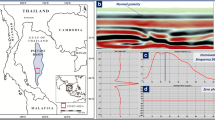Abstract
Fluvial sands host excellent oil and gas reservoirs in various fields throughout the world. However, the lateral heterogeneity of reservoir properties within these reservoirs can be significant and determining the distribution of good reservoirs is a challenge. This study attempts to predict sand distribution within fluvial depositional systems by applying the Continuous Wavelet Transformation technique of spectral decomposition along with full spectrum seismic attributes, to a 3D seismic data set in the Pattani Basin, Gulf of Thailand. Full spectrum seismic attributes such as root mean square and coherency help to effectively map fluvial systems down to certain depth below which imaging is difficult in the intervals of interest in this study. However, continuous wavelet transform used in conjunction with other attributes by applying visualization techniques of transparency and RGB can be used at greater depths to extract from 3D seismic data useful information of fluvial depositional elements. This workflow may help to identify different reservoir compartments within the fluvial systems of the Gulf of Thailand.

























Similar content being viewed by others
References
Ahmad MN, Rowell P (2012) Application of spectral decomposition and seismic attributes to understand the structure and distribution of sand reservoirs within tertiary rift basins of the Gulf of Thailand. Lead Edge 31:630–634
Ahmad MN, Rowell P (2013) Mapping of fluvial sand systems using rock physics analysis and simultaneous inversion for density: case study from the Gulf of Thailand. First Break 3:49–54
Castagana JP (2006) Comparison of spectral decomposition methods. First Break 24:75–79
Henderson J, Purves SJ, Leppard C (2007) Automated delineation of geological elements from 3D seismic data through analysis of multichannel, volumetric spectral decomposition data. First Break 25:87–93
Morley CK, Racey A (2011) Tertiary stratigraphy. In: Ridd MF, Barber AJ (eds) The geology of Thailand. The Geological Society, London, pp 223–271
Morley CK, Haranya C, Phoosongsee W, Kornsawn A, Wonganan N (2004) Activation of rift oblique and rift parallel pre-existing fabrics during extension and their effect on deformation style; examples from rifts of Thailand. J Struct Geol 26:1803–1829
Morley CK, Charusiri P, Watkinson IM (2011) Structure geology of Thailand during the Cenozoic. In: Ridd MF, Barber AJ (eds) The geology of Thailand. The Geological Society, London, pp 274–334
Partyka G, Gridley J, Lopez (1999) Interpretational applications of spectral decomposition in reservoir characterization. Lead Edge 18:353–360
Peyton L, Bottjer R, Partyka G (1998) Interpretation of incised alleys using new 3-D seismic techniques: a case history using spectral decomposition and coherency. Lead Edge 17:1294–1298
Posamentier HW, Kolla V (2003) Seismic geomorphology and stratigraphy of depositional elements in deep-water settings. J Sediment Res 73:367–388
Racey A (2011) Petroleum geology. In: Barber AJ, Ridd MF (eds) The geology of Thailand. The Geological Society, London, pp 351–392
Sinha S, Routh PS, Anno PD, Castagana JP (2005) Spectral decomposition of seismic data with continuous-wavelet transform. Geophysics 70:P19–P25
Acknowledgments
We thank Fugro-Jason for providing an academic license of their Continuous Wavelet Transform spectral decomposition module which was used in this research. Landmark is also acknowledged for providing academic licenses of GeoProbe, PowerView and SeisWorks for the present research. We also thank management of Chevron Thailand Exploration and Production, Ltd. for permission to publish this paper.
Author information
Authors and Affiliations
Corresponding author
Rights and permissions
About this article
Cite this article
Ahmad, M.N., Rowell, P. & Sriburee, S. Detection of fluvial sand systems using seismic attributes and continuous wavelet transform spectral decomposition: case study from the Gulf of Thailand. Mar Geophys Res 35, 105–123 (2014). https://doi.org/10.1007/s11001-014-9213-0
Received:
Accepted:
Published:
Issue Date:
DOI: https://doi.org/10.1007/s11001-014-9213-0




